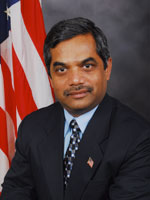Q and A with NEI's Dr Gyan ("John") Prakash, PhD, MBA
November / December 2012 | Volume 11, Issue 6

Dr. John Prakash
As associate director at the National Eye Institute's Office of International Programs - Office of Global Health, Dr. John Prakash plays a key role in overseeing his Institute's international involvement in eye disease research and training. He previously held senior positions at AMAR International and Pfizer Pharmaceuticals' International Division. He earned a Ph.D. in microbiology from the University of Illinois at Urbana-Champaign, and received postdoctoral training in biotechnology at the University of California, Los Angeles, Medical School and the CDC. He earned an M.B.A. in pharmaceutical management at St. Joseph's University in Philadelphia.
What is your perspective on the need for global health research into eye conditions?
Eye conditions affect so much of the population at some point in our lives, whether at birth; as we age, as with macular degeneration; or as a condition brought on by another disease, such as diabetes. That's what makes the research we conduct and support so essential. And we at NEI are committed to taking a global approach. The vision research community is very active in many parts of the world - such as China, India, Brazil, the U.K., Germany and many other countries - and we are looking for discoveries from wherever they may arise. International research can inform us about diseases that are prevalent in many different parts of the world.
Overall, we are emphasizing high-quality science, including molecular biology, genetics and clinical research programs, where we can collaborate and learn from the scientists who are driving the research advances. For many years, NEI has fostered an active interest in international research, collaboration and training, managed through a special office within the Institute. Today, one of our main goals is to sustain a vigorous international research environment, expand collaborations in vision research among different countries and support international partnerships that are providing scientific value to the NEI programs.
How does NEI research address the enormous disease burden in low- and middle-income countries?
Eye diseases are prevalent around the world. No area is free from blindness, although most blindness occurs in developing countries. What's more, up to 80 percent of blindness is preventable. We want to work with the global research and health care communities to stop vision loss before it happens. Much of what we learn about eye health comes from performing global research and from studying specific patient populations, such as pediatric or elderly patients. Country- or region-specific research might provide more in-depth answers to the causes of blindness.
What is the makeup of NEI's international and global portfolio?
We have underway more than 50 international collaborations, projects, affiliations and other engagements on all six continents. The heaviest concentration of our collaborative engagements is in Asia, which accounts for about 40 percent, while 35 percent of our global initiatives are in Europe and the rest are elsewhere. In India, for example, the Aravind Eye Hospital is working with the U.S. Cleveland Clinic to identify primary open-angle glaucoma biomarkers. And Harvard University is collaborating with the L.V. Prasad Eye Institute to develop pluripotent stem cells for eye diseases and with Sankara Nethralaya in genetic studies. It's a very exciting time to be working in this area.
How does NEI plan to foster the next generation of global health scientists?
One of NEI's key global health goals is to develop human capital in the U.S., so we're ready to meet whatever needs arise in vision research and training. This means supporting excellent mentors to train the next generation of scientists and professionals. In fact, the NEI has a record of training numerous scientists in our intramural labs who have returned to their original countries. Several have become leaders there. We are currently training 66 international scientists and fellows in NEI's intramural labs, generally one or two from a given country, but 16 from China, 15 from India and 8 from Korea. In the past two years, 18 trainees have completed their studies and returned to their homes to continue their careers in global health and vision research.
We also manage an NIH-wide effort, the Khorana-Nirenberg Scholars Program, to train scientists of exceptional ability and potential as leaders in their countries. The training is in any field, not necessarily eye research. Once they are established in their countries, there is a high probability they will continue to conduct research, train others at home, and create long-term partnerships, including many with colleagues in the U.S.
More Information
To view Adobe PDF files,
download current, free accessible plug-ins from Adobe's website.